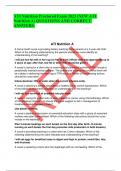Summary
SUMMARY OF whole Fundamentals of Corporate Finance By Ross and Westerfield and Jordan (10th Edition)USE LIFE LONG FOR FINANCE SECTOR JOBS TEACHING LEARNING EARNING ONLINE
- Module
- Institution
- Book
THE ONLY SUMMARY YOU WILL HAVE SEEN THAT ACTUALLY COVERS THE WHOLE BOOK! ALL THE OTHERS SEEM TO STOP AT CHAP 14, BUT YOUR CLASS GOES OVER THE ENTIRE BOOK SO THIS IS SUPER HELPFUL!! Good stuffs, complete summary of the whole book. READ THE INTRODUCTION BELOW : INTRODUCTION Corporate finan...
[Show more]













